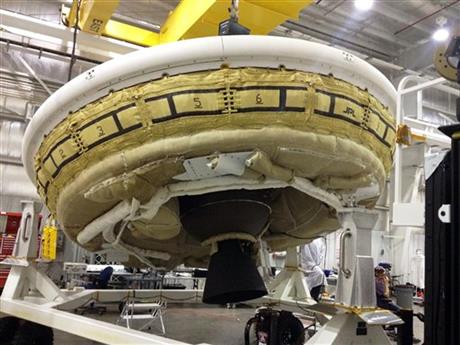
By ALICIA CHANG
FILE – In this undated file photo provided by NASA, a saucer-shaped test vehicle known as a Low Density Supersonic Decelerator holding equipment for landing large payloads on Mars is shown in the Missile Assembly Building at the US Navy’s Pacific Missile Range Facility at Kekaha on the island of Kauai in Hawaii. The U.S. space agency is deciding its next move after it lost the chance to launch the vehicle into the Earth’s atmosphere because of unfavorable wind conditions. The mission is designed to test technology that could be used on Mars. (AP Photo/NASA, File)
NASA Mars Test
In this undated photo provided by NASA, an engineer works on the Parachute Deployment Device of the Low Density Supersonic Decelerator (LDSD) test vehicle in this image taken at the Missile Assembly Building at the US Navy’s Pacific Missile Range Facility at Kekaha on the island of Kaua‘i in Hawaii. From high altitudes above Earth, the vehicle will test two devices for landing future heavy payloads on Mars. The U.S. space agency is deciding its next move after it lost the chance to launch the vehicle into the Earth’s atmosphere because of unfavorable wind conditions. The mission is designed to test technology that could be used on Mars. (AP Photo/NASA)
Prev
1 of 2
Next
LOS ANGELES (AP) — NASA hopes to try again to launch a “flying saucer” into Earth’s atmosphere to test Mars mission technology after losing the chance because of bad weather, project managers said Thursday.
The space agency is working with the U.S. Navy on the Hawaiian island of Kauai to see if it can get the experimental flight off the ground in late June.
During the current two-week launch window, the team came “tantalizingly close,” but winds spoiled every opportunity, said project manager Mark Adler of the NASA Jet Propulsion Laboratory.
Winds must be calm for a helium balloon to carry the disc-shaped vehicle over the Pacific so it doesn’t stray into no-fly zones.
“We’re ready to go. We’re not giving up,” Adler said.
NASA has invested $150 million in the project so far, and extending the launch window would come with some cost. If the flight doesn’t happen this summer, it would be postponed until next year.
The mission is designed to test a new supersonic vehicle and giant parachute in Earth’s stratosphere where conditions are similar to the red planet.
For decades, NASA relied on the same parachute design to slow spacecraft streaking through the thin Martian atmosphere. The 1-ton Curiosity rover that landed in 2012 used the same basic parachute as the twin Viking landers in 1976.
With plans to land heavier payloads and eventually astronauts, NASA needed to develop new drag devices and a stronger parachute.
Measuring 110 feet in diameter, the new parachute is twice as large as the one that carried Curiosity. Since it can’t fit in a wind tunnel where NASA does its traditional testing, engineers looked toward the skies off Kauai.
NASA had rigged the test vehicle with several GoPro cameras with the hope that viewers would follow the action live online.
Project scientist Ian Clark called the weather delay “hardly even a hiccup” in the long road to landing spacecraft on Earth’s planetary neighbor.
“We’re still very enthusiastic,” Clark said. “We’re still very optimistic about the opportunities that we think we’ll have in front of us to do this test.”
___


